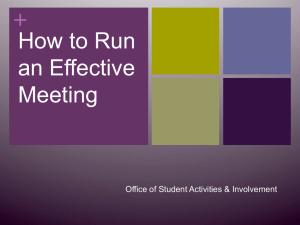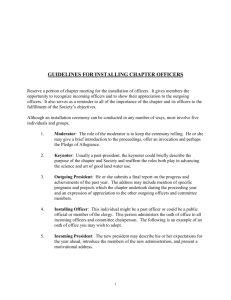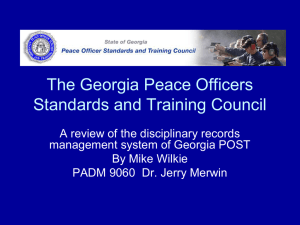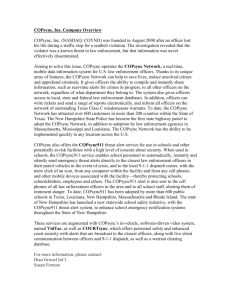Click here for full course information and registration form
advertisement
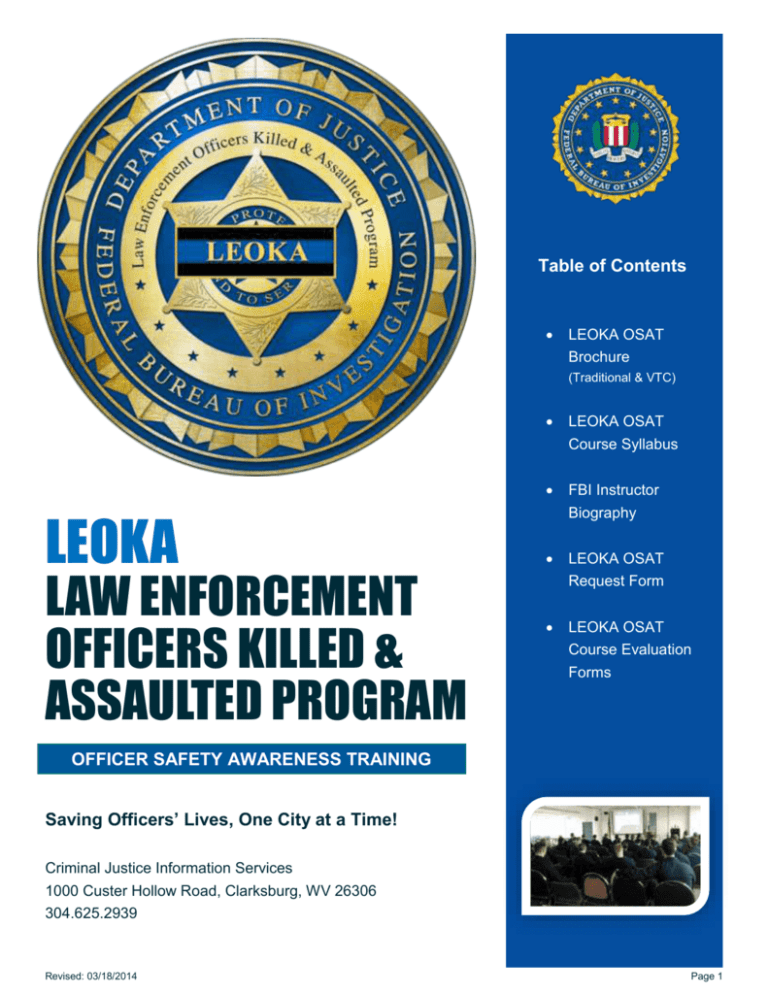
Table of Contents LEOKA OSAT Brochure (Traditional & VTC) LEOKA LAW ENFORCEMENT OFFICERS KILLED & ASSAULTED PROGRAM LEOKA OSAT Course Syllabus FBI Instructor Biography LEOKA OSAT Request Form LEOKA OSAT Course Evaluation Forms OFFICER SAFETY AWARENESS TRAINING Saving Officers’ Lives, One City at a Time! Criminal Justice Information Services 1000 Custer Hollow Road, Clarksburg, WV 26306 304.625.2939 Revised: 03/18/2014 Page 1 Kristin Cadieux Special Agent, FBI kristin.cadieux@ic.fbi.gov Revised: 03/18/2014 Page 2 Date: March 17, 2016 Time: 8:00am – 5:00pm Location: Great Oaks Police Academy Revised: 03/18/2014 Page 3 FBI LEOKA PROGRAM – OSAT COURSE SYLLABUS Course Syllabus The Results of over 20 years of National Studies involving the felonious killing and assaulting of Law Enforcement Officers. (8 hour program) DESCRIPTION: This program provides information on the history and policy relating to the LEOKA (Law Enforcement Officers Killed and Assaulted) Program. Also provided are in-depth analyses of two studies which were concluded in 1992 and 1997, and resulted in the publications “Killed in the Line of Duty” and "In the Line of Fire." The objectives of these studies were to identify elements in certain situations which led to the ultimate felonious deaths and serious injuries of police officers. Demographic and behavioral descriptors for the victim officers and the offenders were developed and will be presented. The findings and resulting safety training issues will also be presented. The emphasis of the presentation will be focused on the final companion study which was concluded in 2006, and resulted in a publication entitled “Violent Encounters.” This study examines 40 incidents where police officers survived life threatening attacks. Demographic and behavioral descriptors for the victim officers and the offenders were developed and will be presented. The findings and resulting training issues will be presented. OBJECTIVE: To assist law enforcement managers, trainers and personnel in the identification of training issues for the purpose of preventing the deaths and/or serious injuries of law enforcement personnel. PRESENTATION MEDIUM: Course content is presented by an instructor. Lecture and discussion is augmented by videotapes of the offenders and victim law enforcement personnel. Handout materials will consist of “Killed in the Line of Duty,” "In the Line of Fire," and "Violent Encounters." Revised: 03/18/2014 Page 4 FBI LEOKA PROGRAM – OSAT COURSE SYLLABUS 8:00-9:00AM INTRODUCTION Objectives: The student will be able to recite the FBI’s involvement with Officer Safety The student will explain the procedure involved with the “Survivor Benefits” administered by the Public Safety Officer’s Benefit Program and the FBI’s role in the line-of-duty officer deaths The student will be able to state the mission of the LEOKA program The student will be able to list the three research studies which are the basis of the LEOKA Officer Safety Awareness Training. If given a computer the student will be able to locate the FBI’s yearly report, Officers Killed & Assaulted The student will be able to recount the number of officers killed and assaulted during the given year The student will be able to apply the research methodology called the Integrative Approach as it applies to violent encounters The student will be able to discuss the “Deadly Mix” The student will list both the “Offender Characteristics” & “Officer Characteristics” of the players involved in the “Violent Encounters” study The student attendee will be able to verbalize the demographic and behavioral descriptors for the victim officers and the offenders. The student will watch (8) eight short video clips and explain how each relates to the subject matter presented. 9:10-10:00AM FOOT PURSUITS Objectives: The student will be able to list the number of officers that have been seriously injured conducting foot pursuits in the last two LEOKA studies The student will list some of the hazards that exist as a result of foot pursuits The student will be able to argue for the need of a foot pursuit departmental policy and training The student will learn common locations for weapon concealment on the body of an offender The student will be able to discuss the “level of cost” that is acceptable relative to officer safety when involved in foot pursuits The student will view (5) five short video clips and explain how each relates to the subject matter presented The student will be able to recite officer strategies as related to foot pursuits The student will be able to list several tactical moves which will aid them in foot pursuits. The student will be able to explain how “Increased Distance” will provide an officer with “Greater Opportunity to Respond to the threat which ultimately increases the officers chance of survival At the conclusion of the “Foot Pursuit” segment the student will be able to develop a personal checklist of safety considerations relative to foot pursuits. 10:10-11:00AM FACING DRAWN GUN Objectives: Students will be able to cite the number of officers assaulted by firearms Students will be able to explain the reasons for developing policies and training in the area of facing a drawn gun Students will view (10) ten short video clips and explain how each relates to the subject matter presented Students will be able to convey the actions of officers that were “facing a drawn gun”, as portrayed in the two most current studies, In the Line of Fire and Violent Encounters Students will be able to debate the success of developing a “game plan” to survive facing a drawn gun Revised: 03/18/2014 Page 5 FBI LEOKA PROGRAM – OSAT COURSE SYLLABUS 11:10–12:00PM HANDCUFFING & CONTROLLING ARRESTS Objectives: Students will be able to list the inherent dangers in the arrest and handcuffing of law violators and violent offenders. Students will be able to recite the number of officers killed in the last ten years while in the process of arresting a suspect. The student will recall the advantages a suspect has over an officer in an arrest situation Within the context of the last two studies, the student will be able to list the number of officers who had their handgun removed during an arrest situation The students will watch (10) ten short video clips and explain how each relates to the subject matter presented The student will be able to list the traits of a person with anti-social personality disorder The student will be able to demonstrate “spin” moves that are effective in removing an officer’s weapon The student will be able to intelligently discuss the offenders “first shot advantage” 12:00-1:00PM LUNCH 1:00-1:30PM ACCIDENT VIDEO “Is Today Your Day?” The students will watch a 20 minute video sponsored by the IACP and LEOKA Program which discusses the importance of speed control and wearing a seatbelt. The students will see and hear first-hand accounts, via the video, of the trauma faced by family members of fallen officers who died in motor vehicle accidents. The students will see and hear from police officers around the Nation, who have been in serious car accidents, the value of slowing down and wearing a seatbelt. 1:30-2:00PM SREET COMBAT VETERANS Objectives: The students will understand the term “street combat veteran” and how it is applied. The students will learn at what age the 2nd Study offenders began carrying a firearm on a regular basis. The students will see videos of study participants discussing their firearm practice rate. The students will become familiar with the term “Instinctive Shooter” and understand its application. The student will learn the use of firearm percentage success rate for officers within the 2nd study. The student will learn the use of firearm percentage success rate for offenders within the 2 nd study. The student will discuss the differences in success rates of both officers and offenders. 2:00-2:30PM TRAINING Objectives: The student will learn various reasons why training is critically important. The student will learn the term “Autopilot” and understand its meaning. The students will meet several study participants via video and hear how training was instrumental in saving their lives. The students will hear from two officers via video who will talk about the benefit of autopilot and how it saved their lives. Revised: 03/18/2014 Page 6 FBI LEOKA PROGRAM – OSAT COURSE SYLLABUS 2:40–3:15PM TRAFFIC STOPS Objectives: The student will be able to argue about the safety of approaching a vehicle during a traffic stop The students will discuss the reasons for complacency relative to traffic stops The student will list the common areas of weapon concealment within a motor vehicle Students list the number of officers assaulted during traffic stops in 2012 The students will list and discuss the procedural errors identified in the Violent Encounters study The students will view (5) five short video clips and explain how each relates to the subject matter presented The students will demonstrate sound effective tactics that should be used during a traffic stop The students will recite indicators that should arouse suspicion/caution of officers during traffic stops Students will be able to demonstrate the “Contact & Cover Approach” when approaching a vehicle 3:15–4:00PM WILL TO WIN / WILL TO SURVIVE Objectives: Students will be able to explain the reasons for developing policies and training in the area of developing a winning mind set Students will view several short video clips and explain how each relates to the subject matter presented Students will be able to convey the actions of officers who were mentally prepared for facing critical injury encounters. Students will be able to debate the success of developing a “game plan” to survive during critical injury encounters. Students will see via video interviews that officers can face serious/critical injuries and still stay in the fight. Students will learn the importance of never giving up. 4:10-5:00PM CONCLUSION Objectives: The student will re-state the number of officers killed from a historical perspective The students will be able to seek out information from the LEOKA publication “Officers Killed & Assaulted related to, “the most dangerous work hours, most dangerous call for service, most dangerous day of the week, etc. The students will list officer behavioral descriptors that negatively impacted their encounter and may have contributed to their attack The students will be able to list and explain the components of the “deadly mix” The students will be able to assess the statements of offenders who perceived officers as weak The students will view (8) eight short video clips and explain how each relates to the subject matter presented The student will be able to explain if officer attacks are based on perceived opportunity The student will be able to evaluate the most dangerous officer descriptor, “Thinks he/she can “read” persons and or situations, and drops their guard as a result”. The student will verbalize the reasons complacency develops in officers The student will be able to diagram the area of an officer known as their “personal space” The student will thoroughly explain the Bureau of Justice Administration Pamphlet, “Take A.I.M.” The student will be able to define the acronym A.I.M. The student will be able to list the components of Awareness, Image & Mindset The student will be able to defend the process of “Taking AIM” before each tour of duty. Revised: 03/18/2014 Page 7 FBI INSTRUCTOR BIOGRAPHY James “Jimmy” Sheets Federal Bureau of Investigation Law Enforcement Officers Killed & Assaulted Program Officer Safety Awareness Training Instructor Criminal Justice Information Services Division Clarksburg, WV 26306 304-625-3199 Email: james.sheets@ic.fbi.gov Jimmy Sheets, a 24 year veteran of the FBI, started his career with the FBI assigned to the J. Edgar Hoover building in Washington D. C. He joined the FBI Police and graduated from the Federal Law Enforcement Training Center in 1990 where he returned to serve in Washington, DC. Jimmy was promoted to lead police officer in 1994 and transferred to the Criminal Justice Information Services Division in Clarksburg, WV. He was promoted to sergeant in 2003. In 2005, Jimmy completed the FBI’s basic special weapons and tactics training course and served as an assistant team leader on the FBI Police patrol emergency response team. He was promoted to lieutenant in 2008 where he remained until 2012. Jimmy was a patrol commander and supervised various operational programs such as the K9 unit, defensive tactics program, active shooter program, field training exercise program, field training officer program, EMT/ first aid program, and the fitness program. In 2008, Jimmy served as the FBI's "Agency Representative" to the Federal Law Enforcement Training Center at Glynco, GA. He has commanded uniformed officers deployed to major national incidents such as the 1996 Olympics in Atlanta and Hurricane Katrina. Jimmy has also commanded federal officers detailed to Quantico, VA, Newark NJ, and San Juan, Puerto Rico during various FBI operations. Educationally, Jimmy earned B.S. degree in Criminal Justice from Fairmont State University and a Masters of Criminal Justice from Boston University. He is also a graduate of the FBI National Academy's 226th Session. Jimmy is currently a Homeland Security/Leadership and Policy PhD. candidate at Northcentral University. Revised: 03/18/2014 Page 8 FBI LEOKA PROGRAM – OSAT REQUEST FORM Request for LEOKA – OSAT Presentation REQUESTING AGENCY INFORMATION Agency Name: Today’s Date: ---------------------------------------------------------- Contact Person: Last First Position Title: Email Address: Office#: Cell #: Fax #: ☐ 4 Hour Course Time From: To: ☐ 8 Hour Course Time From: To: ( 50 Minimum per day) Approximate # of Attendees: Approx # of Agencies: Primary Presentation Date(s): Alternate Presentation Date(s): Name of Facility: BUREAU APPROVAL SECTION (FOR FBI OFFICIAL USE ONLY) FBI LEOKA Supervisor: (Signature :) Status of Request: ☐ FBI Unit Chief: (Signature :) ☐ Accepted Declined Declined Status of Request: ☐ Revised: 03/18/2014 Accepted ☐ Page 9 FBI LEOKA PROGRAM – OSAT REQUEST FORM Revised: 03/18/2014 Page 10
